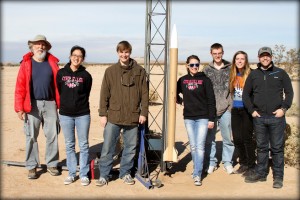
Imagine being one of 35 student teams to compete in—yes!—rocket science.
In a nationwide competition sponsored by the National Aeronautics and Space Administration, Citrus is the only California community college selected to participate in the University Student Launch Initiative, taking place Apr. 17.
Six Rocket Owls accompanied by physics professor Lucia Riderer are scheduled to travel to the Marshall Space Flight Center in Hunstville, Ala. There they will launch the rockets they have built with the feedback of NASA engineers.
Citrus College students are among the finalists going up against launch teams from prestigious programs such as those at the Massachusetts Institute of Technology and the University of Notre Dame.
The NASA competition challenges students to design, build and launch their own reusable rockets. When they are launched their rockets must reach an altitude of approximately one mile.
All teams are required to submit a preliminary design, and second critical design, as well as flight readiness and post-launch assessment review that is done when the competition is over.
Andrew Ferguson, Ben Rhodes-Wickett, Carey Gunter, Jo Jamison, Phoebe Sulzen, and Yu-Han Chiang comprise the Citrus team.
Riderer said the formation of the Rocket Owls came about due to Ferguson’s passion for rockets.
“When I asked him if he was interested in rocketry, Andrew confirmed his passion for it and expressed his interest to form a team of Citrus students to participate in the NASA USLI competition,” Riderer said.
The team is using phenolic tubing for the construction of the rocket. The rocket itself is 6 feet long and measures 4 inches in diameter. The payload is made out of cast acrylic tubing that allows a camera to document the flight. The rocket also contains a sensor system and a single board computer-based GPS and wireless data link.
“Going through the same procedure that NASA goes through for their projects has taught all of us on the team about the complexity of the steps involved,” said Rhodes-Wickett, 27, payload design officer.
“We were advised to increase the nylon webbing that attaches the parachutes to the rocket to help dissipate the forces when the chutes open.”
“Getting feedback from NASA engineers on our own designs has been an invaluable experience.”
Another NASA requirement is that teams must organize outreach events during which they use their expertise to teach children and young adults about making and launching their own rockets. The Rocket Owls use interactive presentations and do demonstrations to help raise interest in science.
Stevenson Middle School in Los Angeles, John Muir High School in Pasadena, Wilson Middle School in Pasadena, and the Glendora Gate Program are among the schools at which the Citrus team has presented.
“We feel it’s important to get kids excited about science, technology, engineering and math (STEM) classes,” Wickett said. “Building something simple like an air-powered soda bottle rocket is a fun way to teach students about science.”
The Rocket Owls met the minimum outreach requirement of presenting to 200 students in November. Now the Rocket Owls have set their goals to reaching 2,000 students.
“I want to share my passion with as many students as possible,” said Sulzen, 23, outreach/technology officer.
“Nothing makes me happier than hearing a young student say ‘I love rockets!’ and that is why we continue to press toward our goal of reaching two thousand people before we consider this project a complete success.”


